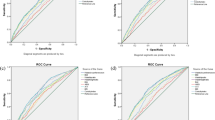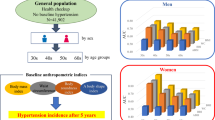Abstract
OBJECTIVE: To examine the relationship between 24 h ambulatory blood pressure monitoring and three commonest anthropometric measurements for obesity—body mass index (BMI), waist-to-hip ratio (WHR) and waist circumference (W).
DESIGN: Cross-sectional survey among outpatients at the Obesity Research Center.
SUBJECTS AND METHODS: Four-hundred and sixty-one overweight or obese subjects, non-diabetic, otherwise healthy, aged 20–70 y, of either sex, were consecutively recruited. All subjects underwent 24 h ambulatory blood pressure monitoring. The population study was separated in normotensive and hypertensive males and females and the possible risk factors for hypertension (W, WHR, BMI and age) were subdivided into different classes of values.
RESULTS: Logistic regression shows that W is the most important anthropometric factor associated with the hypertensive risk. Among males with W≥102 cm the odds ratio (OR) for hypertension is three times that of males with W<94 cm using casual BP measure (OR 3.04), nearly four times higher using 24 h BP mean (OR 3.97), and even five times higher using day-time BP mean (OR 5.19). Females with W≥88 cm have a risk for hypertension twice that of females with W<80 cm, whatever BP measurement was take (casual, 24 h or day-time). Males with WHR≥0.96 and females with WHR≥0.86 show significant OR for hypertension only by 24 h BP measurement and by day-time BP measurement. BMI seems to have no significant relationship to hypertensive risk. Age shows a significant relationship to hypertensive risk only considering males aged ≥55 y and females aged ≥50 y.
CONCLUSION: The waist circumference seems to have a strong association with the risk of hypertension, principally by the ambulatory BP monitoring, when compared with casual BP measurement.
This is a preview of subscription content, access via your institution
Access options
Subscribe to this journal
Receive 12 print issues and online access
$259.00 per year
only $21.58 per issue
Buy this article
- Purchase on Springer Link
- Instant access to full article PDF
Prices may be subject to local taxes which are calculated during checkout
Similar content being viewed by others
References
Kissebah AH, Vydelingum N, Murray R, Evans DJ, Hartz AJ, Kalkhoff RK, Adams PW . Relation of body fat distribution to metabolic complications of obesity J Clin Endocrinol Metab 1982 54: 254–260.
Kalkhoff RK, Hartz AH, Rupley D, Kissebah AH, Kelber S . Relationship of body fat distribution to blood pressure, carbohydrate tolerance, and plasma lipid in healthy obese women J Lab Clin Med 1983 102: 621–627.
Krotkiewski M, Bjorntorp P, Sjostrom L, Smith U . Impact of obesity on metabolism in men and women. Importance of regional adipose tissue distribution J Clin Invest 1983 72: 1150–1162.
Larsson B, Svardsudd K, Welin L, Wilhelmsen L, Bjorntorp P, Tigglin G . Abdominal adipose tissue distribution, obesity and risk of cardiovascular disease and death: 13 y follow-up participants in the study of men born in 1913 Br Med J 1984 288: 1401–1404.
Blair D, Habicht JP, Sims EAH, Sylwester D, Abraham S . Evidence for an increased risk for hypertension with centrally located body fat and the effect of race and sex on this risk Am J Epidemiol 1984 119: 526–540.
Seidell JC, Han TS, Feskens EJM, Lean MEJ . Narrow hips and broad waist circumferences independently contribute to increased risk of NIDDM J Intern Med 1997 42: 401–406.
Han TS, van Leer EM, Seidell JC, Lean MEJ . Waist circumference action levels in the identification of cardiovascular risk factors: prevalence study in a random sample Br Med J 1995 311: 1401–1405.
Han TS, Seidell JC, Curral JEP, Morrison C, Deuremberg P, Lean MEJ . The influence of height and age on waist circumference as an index of adiposity in adults Int J Obes Relat Metab Disord 1997 21: 83–89.
Lean MEJ, Han TS, Seidell JC . Impairment of health and quality of life in people with large waist circumference Lancet 1998 351: 853.
Kanai H, Matsuzawa Y, Kotani K, Keno Y, Kobatake T, Nagai Y, Fujioka S, Tokunaga K, Tarui S . Close correlation of intra-abdominal fat accumulation to hypertension in obese women Hypertens 1990 16: 484–490.
Pickering TG, Devereux RB . Ambulatory monitoring of blood pressure is a predictor of cardiovascular risk Am Heart J 1987 114: 925–928.
Mancia G, Parati G, Pomidossi G, Grassi G, Casadei R, Zanchetti A . Altering reaction and rise in blood pressure during measurement by physician and nurse Hypertension 1987 9: 209–215.
Guagnano MT, Merlitti D, Murri R, Pace Palitti V, Sensi S . Ambulatory blood pressure monitoring in evaluating the relationship between obesity and blood pressure J Hum Hypertens 1994 8: 245–250.
National Diabetes Data Group . Classification and diagnosis of diabetes mellitus and other categories of glucose intolerance Diabetes 1979 28: 1039–1057.
World Health Organization. Physical status: the use and interpretation of anthropometry report of a WHO expert committee WHO Technical Report Series WHO: Geneva 1995.
Crepaldi G, Belfiore F, Bosello O, Caviezel F, Contaldo F, Enzi G, Melchionda N . Italian Consensus Conference—overweight, obesity and health Int J Obes 1991 15: 781–790.
Stolt M, Sjonell G, Astrom H, Rossner S, Hansson L . Improved accuracy of indirect blood pressure measurement in patients with obese arms Am J Hypertens 1993 6: 66–71.
World Health Organization . International Society of Hypertension guidelines for the management of hypertension. Guidelines Subcommittee J Hypertens 1999 17: 151–183.
Clark A, Fowlie S, Coats A, Radaelli A, Van Der Putt M, Bird R, Conway J . Ambulatory blood pressure monitoring validation of accuracy and reliability of the TM-2420 according to the AAMI recommendations J Hum Hypertens 1991 5: 77–82.
O'Brien E, Coats A, Owens P, Petrie J, Padfield PL, Littler WA, de Swiet M, Mee F . Use and interpretation of ambulatory blood pressure monitoring: recommendations of the British Hypertension Society Br Med J 2000 320: 1128–1134.
World Health Organization . Obesity: preventing and managing the global epidemic. Report of a WHO Consultation of Obesity. WHO: Geneva 1997.
Raison JM, Achimastos AM, Safar ME . Sex-dependence of body fat distribution in patients with obesity and hypertension Clin Exp Hypertens 1992 14: 505–525.
Guagnano MT, Ballone E, Merlitti D, Murri R, Pace-Palitti V, Pilotti R, Sensi S . Association between anthropometric and ultrasound measurements of fatness with ambulatory blood pressure monitoring in obese women Int J Obes Relat Metab Disord 1997 21: 632–636.
Ledoux M, Lambert J, Reeder BA, Despres JP . Correlation between cardiovascular disease risk factors and simple anthropometric measures. Canadian Heart Health Surveys Research Group CMAJ 1997 157 (Suppl 1): S46–53.
Ko GT, Chan JC, Woo J, Lau E, Yeung VT, Chow CC, Wai HP, Li JK, So WY, Cockram CS . Simple anthropometric indexes and cardiovascular risk factors in Chinese Int J Obes Relat Metab Disord 1997 21: 995–1001.
Cox BD, Whichelow MJ, Prevost AT . The development of cardiovascular disease in relation to anthropometric indices and hypertension in British adults Int J Obes Relat Metab Disord 1998 22: 966–973.
Okosum IS, Forrester TE, Rotimi CN, Osotimehin BO, Muna WF, Cooper RS . Abdominal adiposity in six population of West African descent: prevalence and population attributable fraction of hypertension Obes Res 1999 7: 453–462.
Lurbe E, Alvarez V, Liao Y, Tacons J, Cooper R, Cremades B, Torro I, Redon J . The impact of obesity and body fat distribution on ambulatory blood pressure in children and adolescents Am J Hypertens 1998 11: 418–424.
Lean MEJ, Hans TS, Morrison CE . Waist circumference as a measure for indicating need for weight management Br Med J 1995 311: 158–161.
Okosum IS, Prewitt TE, Cooper RS . Abdominal obesity in the United States: prevalence and attributable risk of hypertension J Hum Hypertens 1999 13: 425–430.
Acknowledgements
This study was supported in part by research grants from the Ministero dell'Università-Ricerca Scientifica and the School of Medicine, Chieti University, Italy. We are indebted to Mrs Patrizia Di Renzo for assistance in the preparation of the manuscript.
Author information
Authors and Affiliations
Rights and permissions
About this article
Cite this article
Guagnano, M., Ballone, E., Colagrande, V. et al. Large waist circumference and risk of hypertension. Int J Obes 25, 1360–1364 (2001). https://doi.org/10.1038/sj.ijo.0801722
Received:
Revised:
Accepted:
Published:
Issue Date:
DOI: https://doi.org/10.1038/sj.ijo.0801722
Keywords
This article is cited by
-
Comparison of anthropometric and body composition indices in the identification of metabolic risk factors
Scientific Reports (2021)
-
A comparison of trunk circumference and width indices for hypertension and type 2 diabetes in a large-scale screening: a retrospective cross-sectional study
Scientific Reports (2018)
-
The Relationship Between Psychosocial Status and Hypertensive Condition
Current Hypertension Reports (2018)
-
BMI better explains hypertension in Chinese senior adults and the relationship declines with age
Aging Clinical and Experimental Research (2015)
-
Cardiovascular Disease Risk of Bus Drivers in a City of Korea
Annals of Occupational and Environmental Medicine (2013)



